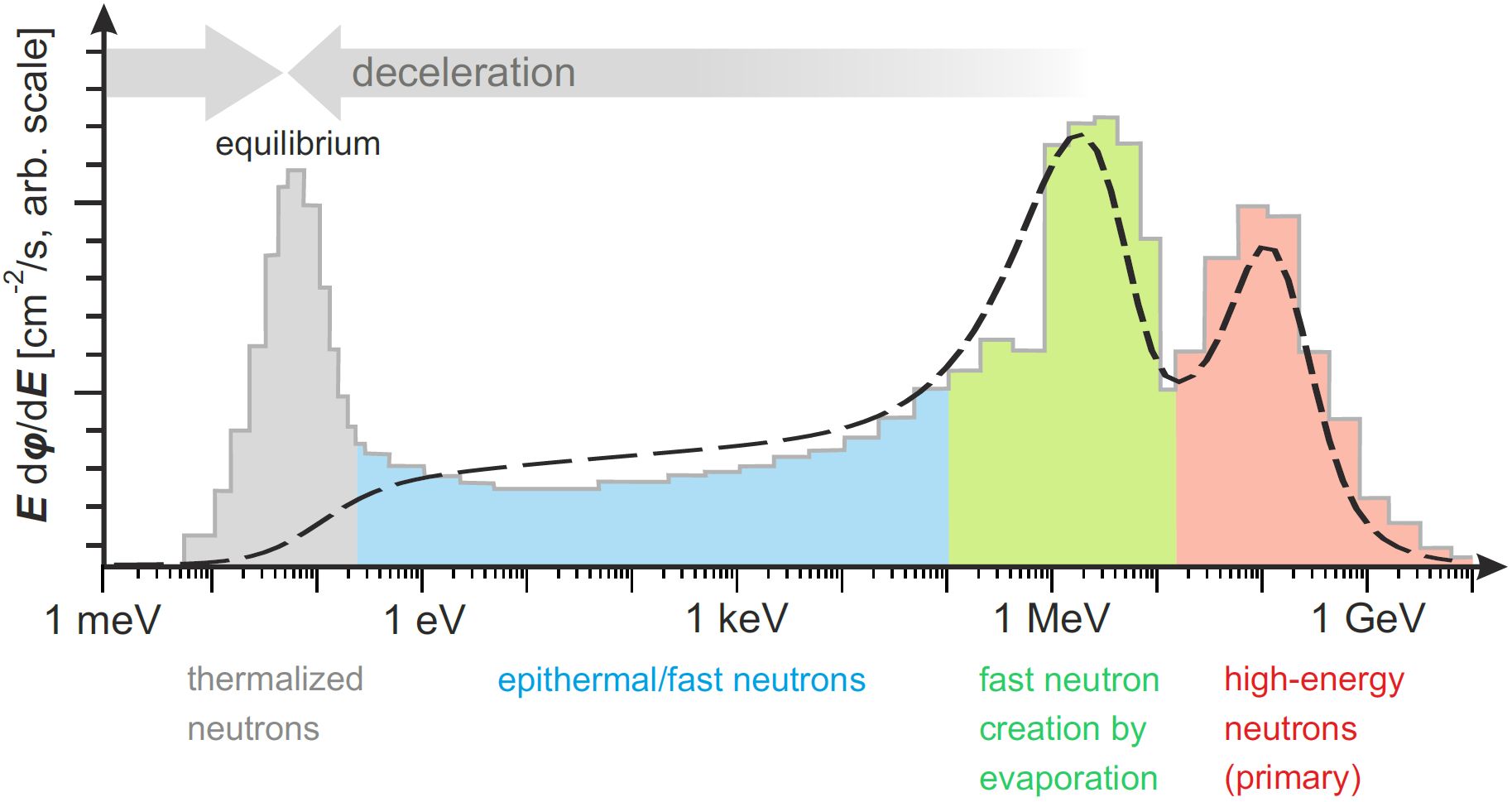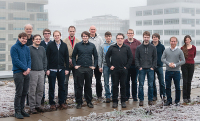CRNS
| The method of Cosmic Ray Neutron Sensing |
|
| Intro | Cosmic-Ray Neutron Sensing (CRNS) is a novel technique for determining soil moisture and a promising tool
for hydrological and environmental applications employing moderated neutron detectors in order
to measure the epithermal/fast neutron albedo flux. Cosmic radiation is omnipresent on Earth and produces neutrons that interact with the atmosphere and the ground. These neutrons mainly originated from a cascade of secondary neutrons as a result of the interaction of high-energy primary cosmic rays with the atmosphere. Secondary neutrons continue to lose energy during numerous collisions with nuclei in the atmosphere and soil leading to energies in the epithermal to fast energy range (1 eV to 105 eV). Such are highly sensitive to hydrogen, which turns neutron detectors using the principle of Bonner Spheres to effcient proxies for changes of environmental water content. The detector is usually mounted 1-2 meters above the ground surface, providing a significant exposure to far-field radiation from albedo neutrons which have further penetrated tens of decimeters into the soil. Hence, the neutron count rate is representative for the average root-zone water content in a footprint of several tens of hectares. The developments in the last years led to an enormous success of the method due to its large footprint, low maintenance, and non-invasive nature. |
|---|---|
| Spectrum |
The neutron energy spectrum above the ground can be devided into three regimes
highly energetic neutrons around 100 MeV, evaporation neutrons around 1 MeV, and low-energy neutrons, which are in thermal equilibrium with the environment (less than 0.5 eV).
Epithermal and fast neutrons are especially sensitive to energy-loss via elastic
collisions with hydrogen and have energies between 0.5 eV and 100 keV. Since soil moisture
is one of the largest sources of hydrogen present in terrestrial systems, it largely influences the presence of fast neutrons in the lower atmosphere.
Thus, relative changes in the density of fast neutrons are strongly correlated
with soil moisture changes.  |
| Detection Technology |
|
| Basics |
Neutrons leave no trace while traveling through matter. They have first to be converted
to high energetic ions by means of nuclear reactions to become measurable. The traces of
these ions are finally detected in a gaseous detector, like a wire chamber or a proportional
counter tube. In case of 3He the converter and counting gas are identical, leading to a very
simple system: A 3He filled proportional counter tube. The cross section, and therefore the
conversion probability of the primary nuclear reaction, is inverse proportional to the square
root of the kinetic energy of the neutron. As a consequence, only thermalized neutrons
have low enough energies to encounter a conversion reaction with high enough probability
to be effectively detected. So on the one hand neutron detectors are primarily sensitive to
thermal neutrons. On the other hand measuring just thermal neutrons is not very useful for
the purpose of CRNS, as their local density depends only weakly on the soil moisture of the
surrounding ground in the far field. In contrast, the local density of higher
energetic neutrons, mainly epithermal ones, strongly depends on soil moisture. Therefore it is
inevitable to surround the neutron detector by a moderator, which thermalizes the epithermal
neutrons, so that they become detectable. Unfortunately the availability of 3He is rather limited after the so-called helium-3 crisis. Today, ten years later, 3He based neutron counters still exists, but they are too expensive to be an affordable technology for mass coverage in CRNS. Since then many efforts were undertaken to establish a replacement technology for 3He based neutron detectors. For a large detection volume and mass production only neutron detectors based on 10B as a converter could be established. Some though replaced the 3He filled proportional counter tubes by proportional counter tubes 3 times bigger in volume and filled with 10BF3. Contrary to the case of 3He based neutron detectors, 10BF3 serves only as neutron converter and not as a counting gas, which has to be added. The 10BF3 solution has two disadvantages compared to 3He. BF3 gas is highly toxic, a fact that raises concerns about the applicability in CRNS. Even with an enlarged volume the count rate is only 60% of the 3He setup. The comparatively poor performance is mainly caused by the fact that boron trifluoride serves only at low (partial) pressures about below one atmosphere as a counting gas. Also the cross section of the neutron conversion of 10B is only 72% compared to 3He. A different approach is to use solid 10B as converter in combination with a simple counting gas. The conversion ions have to escape into the surrounding gas in order to be detected. This limits the 10B layer thickness to micrometers, resulting in a conversion efficiency of around 5% for thermal neutrons, one tenth compared to helium. Consequently, for an efficient detector the neutron flight path has to cross many converter layers. To fulfill this requirement quite different designs have been developed and optimized for various applications. The European Spallation Source with its huge yet-to-be instrumented area has switched to building most detectors on the basis of solid boron carbide layers. |
| Publications |
|
| 2021 | J. Jakobi et al. The footprint characteristics of cosmic ray thermal neutrons Geophysical Research Letters, 48(15), e2021GL094281, DOI: 10.1029/2021GL094281 |
|---|---|
| 2021 | A. Badiee et al. Using Additional Moderator to Control the Footprint of a COSMOS Rover for Soil Moisture Measurement Water Resources Research, 57, e2020WR028478, DOI: 10.1029/2020WR028478 |
| 2021 | M. Köhli et al. Soil Moisture and Air Humidity dependence of the above-ground cosmic-ray neutron intensity Front. Water, 2, 1-15, DOI: 10.3389/frwa.2020.544847 |
| 2020 | J. Weimar et al. Large-scale boron-lined neutron detection systems as a 3He alternative for Cosmic Ray Neutron Sensing Front. Water, 2, 1-16, DOI: 10.3389/frwa.2020.00016 |
| 2020 | B. Fersch et al. A dense network of cosmic-ray neutron sensors for soil moisture observation in a pre-alpine headwater catchment in Germany Earth Syst. Sci. Data, 12(3), 2289-2309, DOI: 10.5194/essd-12-2289-2020 |
| 2019 | P. Schattan et al. Sensing area-average snow water equivalent with cosmic-ray neutrons: the influence of fractional snow cover Water Resources Research, 55, 10796-10812, DOI: 10.1029/2019WR025647 Chosen as Cover Article |
| 2019 | D. Li et al. Can Drip Irrigation be Scheduled with Cosmic-Ray Neutron Sensing? Vadose Zone J., 18:190053, DOI: 10.2136/vzj2019.05.0053 |
| 2018 | M. Köhli et al. Response Functions for Detectors in Cosmic Ray Neutron Sensing Nucl. Instr. and Meth. A, (accpeted, in press), - arXiv:1801.07997 |
| 2018 | M. Schrön et al. The Cosmic-Ray Neutron Rover - Mobile Surveys of Field Soil Moisture and the Influence of Roads Water Resources Research, 54, - DOI: 10.1029/2017WR021719 |
| 2018 | M. Schrön et al. Intercomparison of cosmic-ray neutron sensors and water balance monitoring in an urban environment Geosci. Instrum. Method. Data Syst. 7, 83-99 DOI: 10.5194/gi-7-83-2018 |
| 2017 | M. Schrön et al. Improving calibration and validation of cosmic-ray neutron sensors in the light of spatial sensitivity Hydrol. Earth Syst. Sci. 21, 5009-5030 DOI: 10.5194/hess-21-5009-2017 |
| Chosen as Highlight Article in Hydrology and Earth System Sciences European Geosciences Union Open Access Journals | |
| 2015 | M. Köhli et al. Footprint characteristics revised for field-scale soil moisture monitoring with cosmic-ray neutrons Water Resources Research, 51, 5772-5790 DOI: 10.1002/2015WR017169 - Project in close collaboration with Martin Schrön, UFZ Leipzig |
| 2015 | M. Schrön et al. Monitoring Environmental Water with Ground Albedo Neutrons and Correction for Incoming Cosmic Rays with Neutron Monitor Data PoS (ICRC2015) 231 (to be published) Preview |
Literature
- ...
- ...

